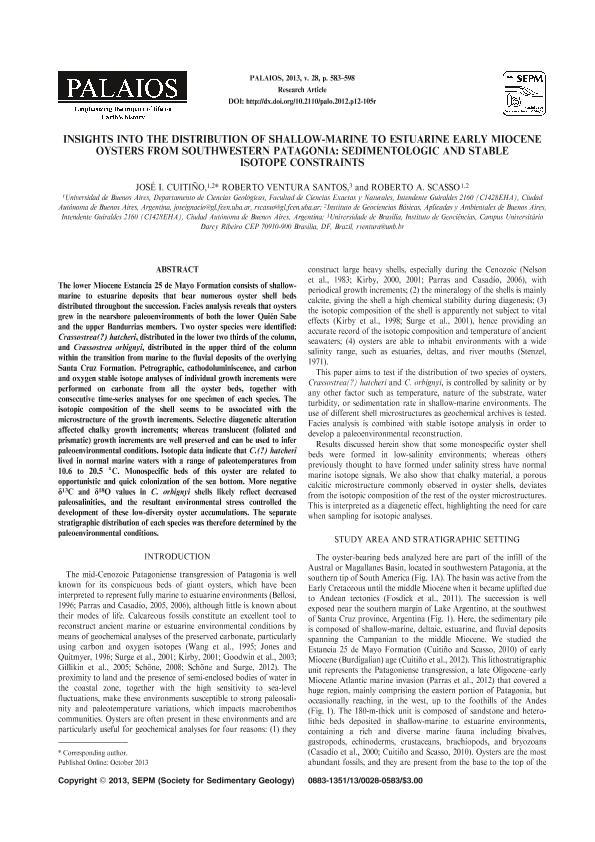Mostrar el registro sencillo del ítem
dc.contributor.author
Cuitiño, José Ignacio

dc.contributor.author
Santos, Roberto Ventura
dc.contributor.author
Scasso, Roberto Adrian

dc.date.available
2017-06-12T21:09:59Z
dc.date.issued
2013-06
dc.identifier.citation
Cuitiño, José Ignacio; Santos, Roberto Ventura; Scasso, Roberto Adrian; Insights into the distribution of shallow-marine to estuarine Early Miocene oysters from southwestern Patagonia: sedimentologic and stable isotope constraints; Society For Sedimentary Geology; Palaios; 28; 6-2013; 583-598
dc.identifier.issn
0883-1351
dc.identifier.uri
http://hdl.handle.net/11336/18042
dc.description.abstract
The early Miocene Patagoniense transgression in southwestern Patagonia, Argentina (Estancia 25 de Mayo Formation), consists of shallow marine to estuarine deposits that bear numerous oyster shell beds distributed all over the sedimentary column. Sedimentary facies analysis reveal that oysters grew in the nearshore paleoenvironments of the stratigraphically lower Quién Sabe Member, as well as in the tide-dominated, shallow marine to estuarine paleoenvironments ofthe upper Bandurrias 26 Member. Two species lying in separate portions of the column were identified: Crassostrea? hatcheri, distributed in the lower two thirds of the column and Crassostrea orbignyi, distributed in the upper third of the column, within the transition from marine to fluvial deposits. Petrographic, cathodoluminiscence, and carbon and oxygen stable isotope analyses for individual growth increments were performed on all the oyster beds, together with serialized intra-shell analyses for one specimen of each species. The stable isotope composition of the shell was found to be strongly controlled by the microstructure due to selective diagenetic alteration of the chalky material whereas translucent (foliated and prismatic) layers are well preserved and can be used to infer paleoenvironmental conditions. Isotopic and sedimentologic data indicates that C.? hatcheri lived in shallow, normal marine waters with a range of paleotemperatures from 11º to 19ºC. Monospecific beds of this oyster are related to opportunistic and quick colonization of sea bottom. Decreasing growth rates along the ontogeny of thisoyster are registered. Highly depleted C and O isotope ratios in C. orbignyi shells resulted from paleosalinity decrease, and environmental stress controlled the development of these low-diversity oyster accumulations. The separate stratigraphic distribution of each oyster species was therefore controlled by the paleoenvironmental conditions.
dc.format
application/pdf
dc.language.iso
eng
dc.publisher
Society For Sedimentary Geology

dc.rights
info:eu-repo/semantics/openAccess
dc.rights.uri
https://creativecommons.org/licenses/by-nc-sa/2.5/ar/
dc.subject
Stable Isotopes
dc.subject
Paleoenvironments
dc.subject
Paleosalinity
dc.subject
Oysters
dc.subject
Shell Microstructure
dc.subject.classification
Otras Ciencias de la Tierra y relacionadas con el Medio Ambiente

dc.subject.classification
Ciencias de la Tierra y relacionadas con el Medio Ambiente

dc.subject.classification
CIENCIAS NATURALES Y EXACTAS

dc.title
Insights into the distribution of shallow-marine to estuarine Early Miocene oysters from southwestern Patagonia: sedimentologic and stable isotope constraints
dc.type
info:eu-repo/semantics/article
dc.type
info:ar-repo/semantics/artículo
dc.type
info:eu-repo/semantics/publishedVersion
dc.date.updated
2017-04-28T20:28:21Z
dc.journal.number
28
dc.journal.pagination
583-598
dc.journal.pais
Estados Unidos

dc.journal.ciudad
Lawrence
dc.description.fil
Fil: Cuitiño, José Ignacio. Universidad de Buenos Aires. Facultad de Ciencias Exactas y Naturales. Departamento de Ciencias Geológicas; Argentina. Consejo Nacional de Investigaciones Científicas y Técnicas. Oficina de Coordinación Administrativa Ciudad Universitaria. Instituto de Geociencias Basicas, Aplicadas y Ambientales de Buenos Aires. Universidad de Buenos Aires. Facultad de Ciencias Exactas y Naturales. Instituto de Geociencias Basicas, Aplicadas y Ambientales de Buenos Aires; Argentina
dc.description.fil
Fil: Santos, Roberto Ventura. Universidade Do Brasilia; Brasil
dc.description.fil
Fil: Scasso, Roberto Adrian. Universidad de Buenos Aires. Facultad de Ciencias Exactas y Naturales. Departamento de Ciencias Geológicas; Argentina. Consejo Nacional de Investigaciones Científicas y Técnicas. Oficina de Coordinación Administrativa Ciudad Universitaria. Instituto de Geociencias Basicas, Aplicadas y Ambientales de Buenos Aires. Universidad de Buenos Aires. Facultad de Ciencias Exactas y Naturales. Instituto de Geociencias Basicas, Aplicadas y Ambientales de Buenos Aires; Argentina
dc.journal.title
Palaios

dc.relation.alternativeid
info:eu-repo/semantics/altIdentifier/url/http://palaios.geoscienceworld.org/content/28/9/583
dc.relation.alternativeid
info:eu-repo/semantics/altIdentifier/doi/http://dx.doi.org/10.2110/palo.2012.p12-105r
Archivos asociados
